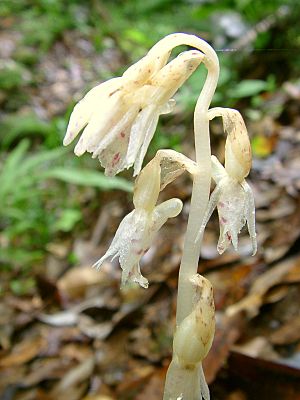Leafless nodding orchid facts for kids
Quick facts for kids Ghost orchid |
|
|---|---|
 |
|
| Epipogium roseum growing near Hiratsuka-city, Japan | |
| Scientific classification | |
| Genus: |
Epipogium
|
| Species: |
roseum
|
| Synonyms | |
|
List
|
|
The Epipogium roseum, often called the ghost orchid or leafless nodding orchid, is a very special plant. Unlike most plants, it doesn't have leaves. Instead, it gets its food from fungi in the soil. This type of orchid can have up to sixteen cream, yellow, or pinkish flowers. These flowers grow on a thick, hollow stem. You can find the ghost orchid in many warm places around the world, including parts of Africa, Asia, New Guinea, Australia, and some Pacific Islands.
What the Ghost Orchid Looks Like
The Epipogium roseum is a leafless plant that grows from the ground. It has a thick underground stem called a rhizome. From this rhizome, a hollow, dull yellow flowering stem grows upwards. This stem can be about 200–600 mm (8–20 in) (8 to 24 inches) tall.
Each plant can have between two and sixteen flowers. These flowers are usually cream, yellowish, or pinkish. They are about 10–12 mm (0.4–0.5 in) (0.4 to 0.5 inches) long and have a noticeably swollen base.
The flower parts include:
- Sepals: These are like small leaves that protect the flower bud. They are long and narrow, about 8–11 mm (0.3–0.4 in) (0.3 to 0.4 inches) long and 2–3 mm (0.08–0.1 in) (0.08 to 0.12 inches) wide.
- Petals: These are often a bit shorter and wider than the sepals. The top sepal and the petals are slightly joined at their bottom parts.
- Labellum: This is a special lip-shaped petal. It is egg-shaped, about 11–14 mm (0.4–0.6 in) (0.4 to 0.55 inches) long and 4–5 mm (0.16–0.20 in) (0.16 to 0.2 inches) wide. It also has a small spur at its base.
In Australia, these orchids usually bloom from December to March. In China, they flower from April to September. The plants often appear just a few days after the first heavy rains of the wet season. They quickly produce seeds within a few days.
How the Ghost Orchid Got its Name
This ghost orchid was first officially described in 1857 by a scientist named David Don. He first named it Limodorum roseum. Later in the same year, another scientist, John Lindley, changed its name to Epipogium roseum.
The second part of its scientific name, roseum, comes from a Latin word. It means "rose-coloured," which describes the pinkish color some of its flowers can have.
Where the Ghost Orchid Lives
The Epipogium roseum orchid loves places with a lot of rain, especially rainforests. It often grows on decaying wood, which is where it finds the fungi it needs for food.
You can find this orchid in many different countries and regions, including:
- China
- India
- Indonesia
- Japan
- Kashmir
- Laos
- Malaysia
- Nepal
- the Philippines
- Sri Lanka
- Thailand
- Vietnam
- Tropical Africa
- New Guinea
- Australia
- Some Pacific islands, like the Solomon Islands
In Australia, it grows from the Windsor Tablelands in Queensland down to the Macleay River in New South Wales.

